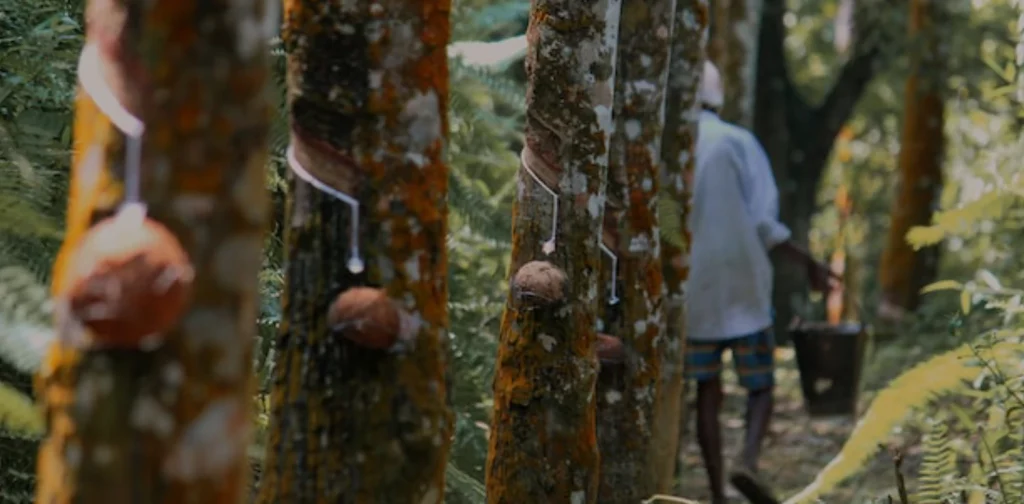Rubber Plantations Cause More Deforestation Than You Think

Photo: Isuru on Unsplash
Rubber plantations are quite a sight: neat rows and rows of slim and tall rubber trees providing shade from the sun. It is easy to forget that these plantations have likely replaced natural forests. A new study reveals a more accurate picture of how rubber plantations in Southeast Asia caused significant deforestation.
Rubber Industry and Deforestation
Rubber is a material produced from the latex of the rubber tree, Hevea brasiliensis. At the end of the 19th century, the tree was introduced from South America to South and Southeast Asia, resulting in the beginning of the rubber industry in the regions. According to the latest data by the FAO, Southeast Asia now produces 90% of global natural rubber.
Besides its latex, the rubber tree is sometimes used for its rubberwood. Traditionally, rubberwood is used to fuel rubber processing, steel industries, tobacco curing, and brick manufacturing.
Globally, at least 90% of tropical deforestation is linked to agriculture, such as in the production of meat, palm oil, soy, coffee, cocoa, and natural rubber. This deforestation is usually mapped using satellite imagery, but it can be rare and difficult.
For natural rubber, accurate mapping is especially tricky because 85% of rubber producers are smallholders with small plantations that are hard to detect. Furthermore, the aerial visual appearance of rubber plantations is similar to natural forests.
More Accurate Picture
A study led by the Royal Botanic Garden Edinburgh shows the extent of deforestation linked to rubber plantations in Southeast Asia. The researchers used high-resolution Sentinel-2 imagery (at a spatial resolution of 10 m) and cloud computing to map rubber plantations across the region in 2021. They also reviewed more than 100 case studies.
Dr. Antje Ahrends, a senior author of this research, said, “With 70% of the world’s natural rubber yields destined for tire manufacture, demand is not likely to diminish. The threat this poses to biodiversity should not be underestimated. In addition, while predominantly grown by smallholders with the potential to support livelihoods, rubber is also associated with land grabbing and human rights infringement in some countries.”
According to the study, there were 14.2 million hectares of mature rubber plantations in Southeast Asia in 2021. More than 70% were in Indonesia, Thailand, and Vietnam. Furthermore, over 1 million hectares of them were in Key Biodiversity Areas.
In terms of deforestation, the study estimates that 4.1 million hectares of forest had turned into rubber plantations between 1993 and 2016, which was at least two or three times higher than the figures widely used to set policy.
Regulating Rubber Plantations in Southeast Asia
Natural rubber is still preferable to its synthetic alternative, which is derived from crude oil and, therefore, more environmentally harmful. Meanwhile, natural rubber is a renewable resource that benefits smallholder farmers.
As demand for natural rubber is projected to keep increasing, the researchers call for “policymakers to give more attention to rubber production in domestic policy, trade agreements, and forthcoming due-diligence legislation.” They also recommend caution and consideration of smallholder farmers who make up the most of this industry when doing so.
Read the full paper here.

Join Green Network Asia Membership
Amidst today’s increasingly complex global challenges, equipping yourself, team, and communities with interdisciplinary and cross-sectoral insights on sustainability-related issues and sustainable development is no longer optional — it is a strategic necessity to stay ahead and stay relevant.
Join Now

 Weaving the Thread Between the Last Elephant and the Floods in Sumatra
Weaving the Thread Between the Last Elephant and the Floods in Sumatra  Bringing Buried Rivers Back to Life Through Daylighting
Bringing Buried Rivers Back to Life Through Daylighting  Prescribing Beyond Profit for CEOs’ Anxiety
Prescribing Beyond Profit for CEOs’ Anxiety  An Interview with May Tan-Mullins, CEO and Provost of University of Reading Malaysia
An Interview with May Tan-Mullins, CEO and Provost of University of Reading Malaysia  An Interview with Eu Chin Fen, CEO of Frasers Hospitality
An Interview with Eu Chin Fen, CEO of Frasers Hospitality  The UK Government’s Funding Package Plan to Tackle Youth Unemployment
The UK Government’s Funding Package Plan to Tackle Youth Unemployment